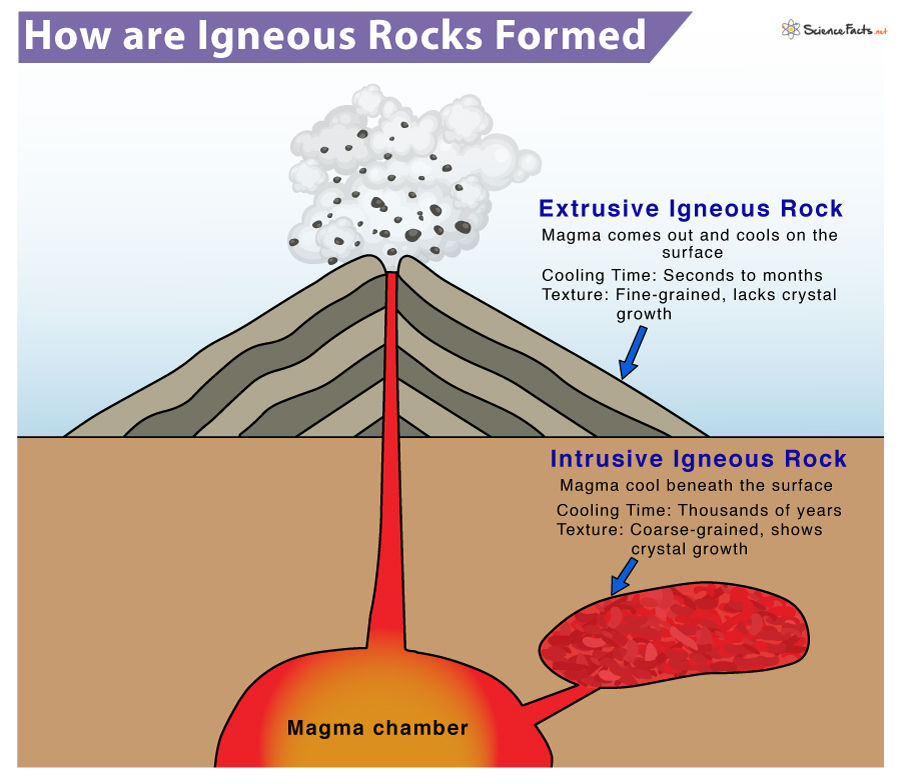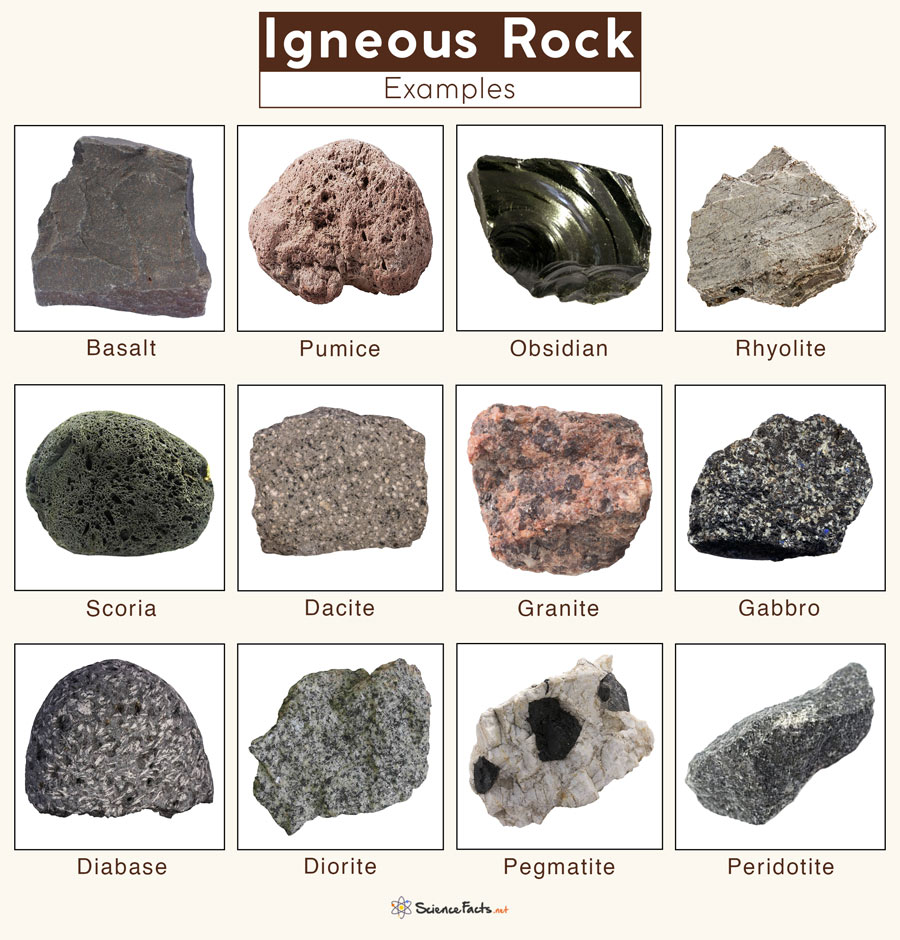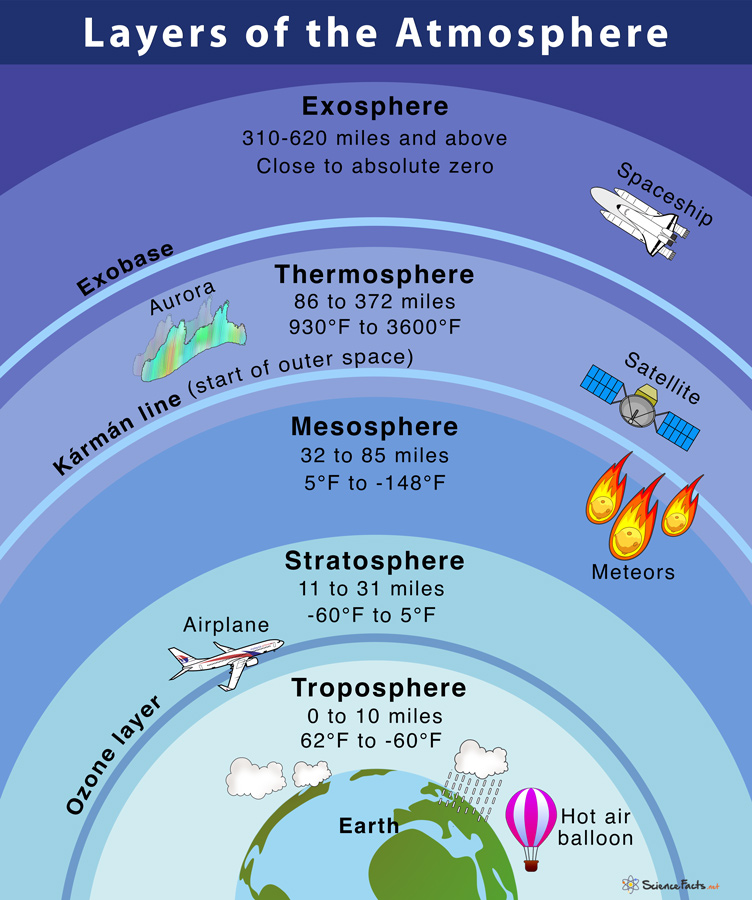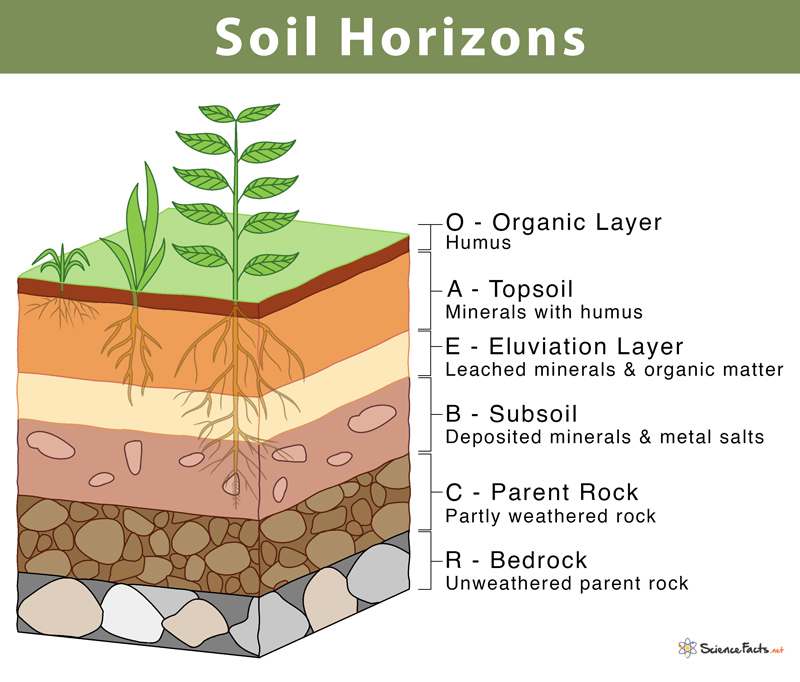Igneous Rocks
The igneous rocks are one of the three main types of rock found on earth; the others are sedimentary rock and metamorphic rock. They are the hardest and heaviest rock on earth. They are also called the ‘new’ rocks or magmatic rocks. Sometimes they are referred to as parent rock because all other rock types are formed from them. The term ‘Igneous’ is obtained from ‘igneus’, which is the Latin word meaning ‘fire’.
Igneous rocks are generally formed by the process of cooling and solidification of hot molten magma. When hot, molten magma at 600 to 1,300 °C (1,100 to 2,400 °F) cools and crystallizes at the earth’s surface or inside the crust, they solidify into igneous rock. The magma develops underground, either in the lower crust or the upper mantle, due to the extreme heat and pressure. When magma gushes out to the surface through cracks or volcanoes, it is called lava. Igneous rocks are formed either at volcanoes on the earth’s surface or deep inside the crust when it is in melted form.
What are Igneous Rock Made of
Igneous rock can look different and have many different compositions, depending on how quickly they cool and solidify. For example, two rocks from identical magma can become either granite or rhyolite. Nevertheless, most igneous rocks are mainly composed of silicate minerals. The presence of igneous rocks in an area might be evidence of a past volcano.
Types: Where and How are they Formed
Igneous rocks are of two main categories based on where the molten rock solidifies. They are named and described below.
1) Extrusive Igneous Rocks
Extrusive or volcanic igneous rocks are formed on the earth’s surface when lava exists and cools almost instantly when exposed to a relatively cool temperature in the atmosphere.
The quick cooling of the lava prevents the mineral crystals from growing and forms a fine-grained or even glassy texture. These fine-grained rocks are known as aphanitic, from a Greek word meaning ‘invisible’. Hot gas bubbles are trapped in the quenched lava, forming a vesicular texture.
Extrusive igneous rocks are found in:
- Hawaii Volcanoes National Park, Hawaii
- Sunset Crater Volcano National Monument, Arizona
- Crater Lake National Park, Oregon
Properties and Characteristics
- Fine-grained that are too small to be identified without a microscope
- Some have rectangular crystals
- Some have vesicles, which are holes caused by gas bubbles
- Very hard
2) Intrusive Igneous Rocks
Intrusive or plutonic igneous rocks develop when magma is trapped deep inside the earth and solidifies without ever reaching the surface. The magma cools and solidifies very slowly over thousands or millions of years in chambers of pre-existing rocks. Slow cooling allows individual mineral grains to grow very long, forming rock with visible, large crystals.
Intrusive igneous rocks are found in:
- Acadia National Park, Maine
- Joshua Tree National Park, California
- Yosemite National Park, California
Properties and Characteristics
- Coarse-grained that are big enough to be seen with the naked eye
- Uniform texture
- Shiny, flat crystals whose edges interlock and fit together like jigsaw puzzle pieces
- Hard
Igneous Rocks Examples
Some common examples of igneous rocks are listed and described below with their names:
Basalt is a hard, black-colored extrusive igneous rock composed mainly of plagioclase and pyroxene minerals.
Pumice is a light-colored vesicular extrusive igneous rock. It is composed primarily of silica and A1-oxide but may contain metal oxides, calcite, or salts.
Obsidian is a dark-colored, extrusive igneous rock that forms due to the rapid cooling of molten rock and thus does not form crystals. Obsidian is produced from felsic lava, rich in lighter elements such as silicon and oxygen.
Rhyolite is a light-colored, fine-grained extrusive igneous rock typically consisting of quartz and feldspar minerals.
Scoria is a dark-colored vesicular extrusive igneous rock formed due to trapped gas at the time of solidification. It is composed of almost 50% silica and 10% calcium oxide with lesser contents of potash and soda.
Dacite is a light-colored (white to light gray), extrusive igneous rock consisting primarily of plagioclase and quartz.
Granite is a light-colored, course-grained intrusive igneous rock consisting of quartz, feldspar, and mica minerals. It is the most common intrusive igneous rock.
Gabbro is a dark-colored, coarse-grained intrusive igneous rock that contains feldspar, pyroxene, and sometimes olivine.
Diabase is a dark grey to the black-colored, course-grained intrusive igneous rock consisting primarily of plagioclase feldspar and pyroxene minerals. The grains in diabase are more extensive than those in basalt but smaller than those in gabbro.
Diorite is a coarse-grained intrusive igneous rock with a contrasting mix of black and white mineral grains. It consists of a mixture of feldspar, pyroxene, hornblende, and sometimes quartz.
Pegmatite is a light-colored, course-grained intrusive igneous rock consisting of quartz, feldspar, and mica, having a similar silicic composition as granite.
Peridotite is a dark-colored, coarse-grained intrusive igneous rock consisting of small amounts of amphibole, feldspar, quartz, or pyroxene.
Uses and Benefits of Igneous Rocks
Igneous rocks are commonly used in flooring, landscaping, and construction purposes. However, its uses are specific to its types. Some specific importance apart from the general ones is given below:
Granite
- Construction of buildings and statues
- Building kitchen countertops
Basalt
- Rich source of iron
- Commonly used as an ingredient of concrete
Pumice
- Abrasive – removing dead skin from the bottom of feet
- Making of lightweight materials such as toothpaste and cosmetic products
Gabbro
- Polishing surfaces
- The raw material of gold and silver
Fun Facts for Kids
- About 95% part of the earth’s crust consists of igneous rock. Earth’s moon also consists of igneous rock.
- There are about 700 types of igneous rocks known to us.
- The ocean floor is made of basalt, which is an igneous rock
- Pumice, the lightest rock on earth, is an igneous rock.
- The Giant’s Causeway in Northern Ireland was made from a lava flow that erupted 55 million years ago. As the lava cooled, it split and formed about 40,000 basalt pillars.
- Batholiths are a substantial igneous intrusion extending deep in the earth’s crust.
FAQs
Ans. A fine-grained and glassy texture commonly characterizes extrusive igneous rocks.
Ans. Intrusive igneous rocks are formed when magma solidifies on the surface of the earth. In contrast, extrusive igneous rocks are formed from magma that cools and solidifies within the earth’s crust.
Ans. No, limestone is a sedimentary rock.
Ans. The melting of metamorphic or igneous rock forms magma.
Ans. The origin of fine-grained igneous rock is magma that erupts from volcanoes in the form of lava.
Ans. Indirectly, yes. An igneous rock changes into sedimentary rock or metamorphic rock. The metamorphic rock can then again change into igneous rock through the rock cycle.
Ans. The igneous rock must be exposed to the earth’s surface for weathering.
Ans. Igneous rocks rarely have fossils in them.
Ans. No, igneous rocks do not have layers.
Ans. The only known igneous rock that floats in water is pumice.
-
References
Article was last reviewed on Friday, February 17, 2023







